This article originally featured in the March 2022 issue of Connect.
Kimberly Matsuno (Niigata)
The sight of young mountain vegetables slowly peeking out of the last remaining piles of snow is a classic scene promising the coming of spring. However, perhaps one of the most amusing sights of the season is watching whole families, touting plastic bags, crouched over along roadsides picking said mountain vegetables.
These mountain vegetables, collectively called “sansai” in Japanese, are not only harbingers of spring but are also nutrient-packed ingredients that are thought to be full of medicinal properties. Distinctly earthy and often bitter, sansai are featured in many springtime Japanese dishes ranging from the humblest of shojin-ryouri (Buddhist cooking) to the fanciest kaiseki-ryouri (Japanese multi-course meals). Sansai can be eaten raw, sauteed, braised, boiled, or battered and fried. And with over 300 different varieties of sansai, the possibilities are endless.
While it’s not recommended to go out on your own to harvest mountain vegetables, many guest houses in the countryside, such as Iromusubi no Yado in Murakami, Niigata, are starting to offer “sansai harvesting experiences” as part of your stay. In experiences such as these, a local guide will take you to a place surrounded by nature and teach you how to harvest sansai that will be prepared by the guest house for dinner the very same day.
Whether you are out foraging with a guide or are just perusing your local farmer’s market, identifying different varieties of sansai and figuring out how to prepare them can be overwhelming. Here is a list of some of the more common and popular sansai to get you started on your mountain vegetable journey.
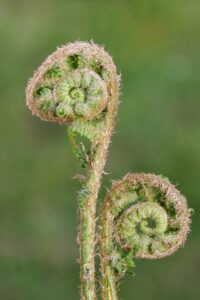
Perhaps the most famous and recognizable sansai is kogomi. In English, these tightly coiled sprouts are known as fiddlehead ferns or ostrich ferns. Raw, these ferns are quite bitter and difficult to digest. However, after boiling, they develop a taste similar to asparagus. Kogomi are typically served after being simmered in dashi and soy sauce or battered and fried as tempura.
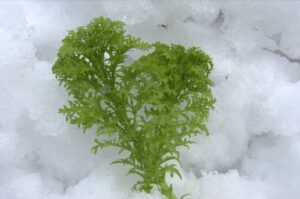
Wasabina, or wasabi mustard greens, take after the wasabi root that they are named after. These greens develop a spicy, wasabi-like flavor as they mature. Young wasabina, with their milder flavor, blend in well with leafy salads. While more mature wasabina, with their curlier leaves, can be cooked into stir-fries or soups.
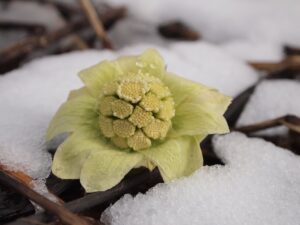
Butterbur stalks (fuki) and their buds (fukinotou) have a taste similar to celery. Fuki are one of the main components in those bags of pre-cooked sansai in water that are commonly found in grocery stores year-round. Fresh fuki stalks are typically prepared by being rolled in salt and then boiled, while the buds are typically served as tempura or sauteed and tossed in miso.
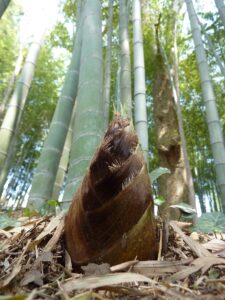
No list of mountain vegetables would be complete without takenoko, otherwise known as bamboo shoots. These baby bamboo shoots are harvested just after they appear out of the ground. Due to the short time frame in which they can be harvested, fresh takenoko are coveted items at any Japanese grocery store—though you can usually find them pre-cooked or canned throughout the year. Fresh bamboo shoots are usually simmered with soy sauce, sake, and sugar. But they can also be boiled and sliced for a salad or prepared as tempura.
Now that you, hopefully, feel a little more confident identifying sansai at your next trip to the farmer’s market, read on to discover two healthy and hearty dishes that are as simple as they are delicious. These recipes can both use your pre-boiled sansai of choice or packaged sansai no mizuni (sansai in water)––so that you can enjoy the flavors of spring year-round.
Sansai Soba
Juno Valerio (Niigata)
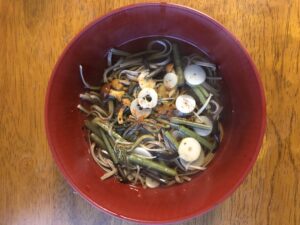
Have you ever wandered around a Japanese supermarket and noticed a bag of vegetables in the produce section and wondered, “What is that? I want to eat it!”? One of those bags is sansai, which are Japanese mountain vegetables. I got in touch with my inner Japanese mountain dweller and made this warm mountain vegetable dish.
This recipe makes two large or four more restrained portions.
Ingredients
- 100 ml (7 tablespoons) homemade or store bought mentsuyu (noodle soup stock)
- 300 ml (1 1/4 cup) water
- 1 bag of boiled sansai in water (山菜の水煮—Sansai no mizuni)*
- 150 grams (5.3 ounces) soft tofu
- 200 grams (7 ounces) soba noodles
*I used a 200 gram (7 ounce) bag, but you can use a smaller bag without changing the other ingredients. A smaller bag just means less delicious mountain vegetables.
Instructions
- Put mentsuyu and water in a pot. Taste the stock for strength and add more mentsuyu or water as you see fit. You do want it to be a little strong right now because you will be adding a lot of mildly flavored things.
- Drain the sansai and add them to the mentsuyu mixture.
- Cut the tofu into pieces you can reasonably fit on a spoon or pick up with chopsticks. Soft tofu does tend to break up a bit in the pot, so it’s better to go for a little bigger than a little smaller. Add the tofu to the pot with the mentsuyu and sansai.
- Turn the stove on medium-high and bring your soup mixture to a boil. While you are waiting for the pot to boil, make your soba according to the package instructions. I suggest stirring the noodles while they cook; otherwise, they can stick together.
- When the soup mixture starts to boil, turn it down to a simmer for five to eight minutes (or approximately how long it takes you to cook the soba). Taste again and adjust by adding more mentsuyu or water as necessary. You do still want it to be a little strong because you are adding it to noodles.
- Divide the soba into bowls and use a ladle or large spoon to add soup mixture over the noodles. This dish is best enjoyed immediately. いただきます (itadakimasu)!
Juno is a first-year JET in rural Niigata, originally from the state of Oregon in America. Due to food allergies, she learned to cook at a young age and is on a mission to make and eat as many allergy-friendly Japanese dishes as possible. Juno writes a blog about her experiences as an ALT in rural Japan.
Sansai Okowa
Tanima Biswas (Tokyo)
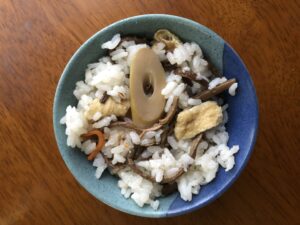
We are always looking for tasty but quick and easy meal ideas in our busy lives. So, I will share a recipe from my Japanese friend’s mom’s kitchen. This vegetable rice is ideal for those who like to cook their meals hassle-free. As a plus point, this dish is also super healthy. The premise is simple; just incorporate mountain vegetables into your plain, regular rice to make it into a delicious, quick, and healthy meal.
This recipe makes four portions.
Ingredients
[Start bulleted list 1-7]
- 1 portion white rice (up to the 180 ml mark on a rice cooker cup)
- 1 portion mochi rice (up to the 180 ml mark on a rice cooker cup)
- 1/2 to 1 packet boiled sansai in water ([[i]]山菜の水煮[[i]]—Sansai no mizuni)
- 1/2 to 1 piece deep-fried tofu ([[i]]油揚げ[[i]]—Aburaage)
- 75 ml (2.5 ounces) shiro dashi ([[i]]白だし[[i]]—Shiradashi)
- 1.5 grams salt
- 300 ml (10 ounces) water
Notes
Using mochi rice with white rice gives this dish a better texture. Both the bite of white rice and the chewiness of mochi rice can be enjoyed at the same time.
Both the packet of mixed boiled mountain vegetables (sansai) and shiro dashi can be bought at supermarkets all year round. Feel free to add more or less vegetables to your dish according to your taste. The amount of vegetables will not affect the cooking time or amount of water required.
Instructions
- Mix the white rice and mochi rice, then wash the mixture well under running water. Set it aside.
- Drain the sansai mix and cut the vegetables into bite-size pieces.
- Pour hot water over the deep-fried tofu and drain the water. This sounds counterintuitive, but it helps to remove the excess oil from the tofu and improves the flavor.
- Cut the tofu into one-centimeter cubes.
- Place the washed rice into the rice cooker, followed by the vegetable mix, shiro dashi, and salt.
- Mix everything together well and add the tofu pieces to the top. Finally, add 300 ml of water, then close the lid and turn on the rice cooker.
- Once the rice is done, open the lid and fluff the rice—mixing all the ingredients, including the tofu, well. This dish is best served hot.
Tanima has a doctorate in organic chemistry and is currently working in a Japanese food company. Cooking is one of her passions besides reading, traveling, and photography. Add her on Facebook to follow along on her journey.
Cover photo: pixabay




